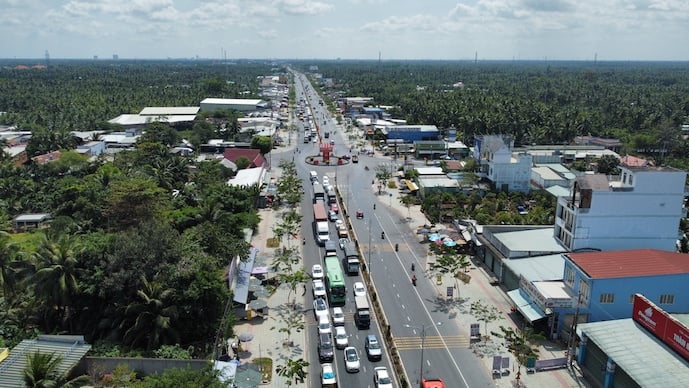 |
| Goods from the Mekong Delta still have to be transited to Ho Chi Minh City for export. Photo: Trung Chanh |
The project of a large-capacity shipping channel into the Hau River was started in late 2009 and inaugurated and put into operation in April 2017, allowing 10,000-ton fully loaded ships and 20,000-ton unloaded ships to enter and exit ports on the Hau River.
Accordingly, at the time of implementation, the project was expected to be able to meet the customs clearance capacity of about 22 million tons of goods per year when completed, helping the Mekong Delta (MD) to directly import and export. However, the actual exploitation was not as expected, the region's goods still had to be transferred to ports in the Southeast region for export.
More than 90% of goods in the Mekong Delta must be exported through other ports.
Recent reports from the Ministry of Transport (now the Ministry of Construction) show that the total volume of goods passing through the Mekong Delta's seaports each year has exceeded 20 million tons, but less than 2 million tons go directly from the Mekong Delta's seaports, meaning that over 18 million tons of goods from the Mekong Delta must go through external seaports, mainly in Ho Chi Minh City.
The above figures clearly reflect that the exploitation of the project of large-capacity shipping channels into the Hau River to help the Mekong Delta directly export goods to the world has not been as effective as expected, which is to clear about 22 million tons of goods per year.
At the recent working session on key transport infrastructure projects in the Mekong Delta held by Prime Minister Pham Minh Chinh in Can Tho city, Mr. Phung Ngoc Minh, Deputy General Director of Saigon Newport Corporation (SNP) - the unit managing Cai Cui port in Can Tho city, admitted that the exploitation of large-tonnage shipping routes into the Hau River has not been effective, even domestic shipping routes connecting Can Tho had to be temporarily suspended after the first few shipments.
Accordingly, at the end of 2016, after the above project was technically cleared, SNP opened the Can Tho - Hai Phong inland waterway route, but by September 2017 it had to be temporarily suspended after 33 ship trips. "By October 2022, we and Vietnam National Shipping Lines (Vinalines, the unit managing Can Tho port, located next to Cai Cui port) jointly launched the Can Tho - Ho Chi Minh City - Vung Ang - Hai Phong route, but by June 2023 it had also been temporarily suspended after operating 7 ship trips," said Mr. Minh, adding that Cai Cui port currently only operates barges to Ho Chi Minh City for export, and cannot receive ships directly from Cai Cui port.
The main reason for having to stop exploitation, as stated by the Deputy General Director of SNP, is that the depth of the shipping channel into the Hau River is not guaranteed, meaning it is silted up, making it impossible to receive large container ships into the port.
Mr. Nguyen Manh Ha, General Director of Can Tho Port Joint Stock Company (a unit of Vinalines), admitted that the exploitation of the waterway into the Hau River is ineffective, causing the logistics costs of goods in the Mekong Delta to remain high. "The current average depth of the waterway is only 3 meters, while to accommodate 10,000-ton fully loaded ships and 20,000-ton partially loaded ships entering and exiting, it must be minus 6.5 meters," Mr. Ha stated the current situation and said that if this difficulty is resolved, the logistics costs for goods in the Mekong Delta will be significantly reduced.
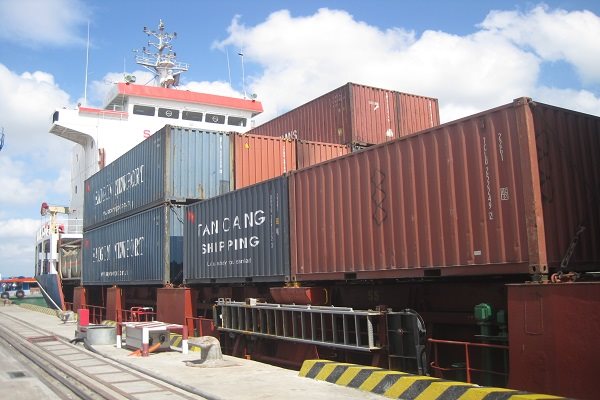 |
| Container ships enter Cai Cui port through the shipping channel into the Hau River at the time this channel was inaugurated. Photo: Trung Chanh |
The shipping channel into the Hau River silts too quickly.
Enterprises operating logistics services in the Mekong Delta region identified the biggest difficulty hindering the direct import and export of goods from the Mekong Delta as the channel for large-capacity ships entering the Hau River silting up too quickly.
To resolve the above situation, Mr. Minh of SNP proposed that the Prime Minister and the Ministry of Construction maintain and dredge the estuary into the Hau River, ensuring the designed depth of minus 6.5 meters. "This is the basis for us to maintain domestic shipping routes as well as exploit intra-Asian and international routes," Mr. Minh emphasized and cited that in 2022, after SNP called for help, a Thai company had a type of ship suitable for the route into the Hau River, but after surveying due to the channel depth not being guaranteed, it decided not to put the ship into operation.
Mr. Ha of Can Tho Port Joint Stock Company also proposed that the Government pay attention to dredging the shipping channel into the Hau River to effectively exploit the Mekong Delta Logistics Center in Can Tho City (located next to Cai Cui Port and Can Tho Port). Because dredging the shipping channel for large ships into the Hau River requires a huge amount of resources, which businesses cannot meet.
Regarding the issue of clearing the channel for large-capacity ships to enter the Hau River, at the meeting, Prime Minister Pham Minh Chinh emphasized that the state cannot always take care of the channel while businesses pocket the profits. “Vinalines is waiting for the state to dredge, Tan Cang is also waiting for the state to dredge. You all want to do it but don’t want to dredge, how can that be?”, the Prime Minister asked.
The Prime Minister suggested that SNP and Vinalines join hands to work together and at the same time take care of clearing the channel into the Hau River to help develop the Mekong Delta. “We must cooperate to exploit the port effectively, then jointly maintain the channel to contribute to that,” the Prime Minister said and suggested that a new legal entity could be established on the basis of merging two units under SNP and Vinalines.
Regarding the above suggestion, according to Mr. Ha, Vinalines has a policy of inviting SNP to cooperate, in which Vinalines holds 65% of the capital and SNP holds 35% to immediately deploy the development of logistics services in the Can Tho area and the Mekong Delta.
However, Mr. Minh said he would report to the manager to have a written answer later, but from a personal perspective, at this time he would not cooperate to establish a new legal entity.
Faced with the above issue, the Prime Minister directed Deputy Prime Minister Tran Hong Ha to chair a meeting in May 2025, with the participation of the Ministry of Construction, Can Tho City, SNP and Vinalines to propose a plan for coordination in exploiting the waterway for large-capacity ships entering the Hau River, with a report by the end of May 2025. "Now that the port and waterway have not been resolved, what kind of logistics center will it be?", the Prime Minister asked and affirmed that if there is no cooperation to resolve the issue, there will be a deadlock as it is now.
Will Tran De Port be the solution to "unblock" the Mekong Delta?
After many years of ineffective large-capacity shipping channel project into Hau River, the investment in Tran De Port in Soc Trang Province, including a wharf to the sea about 18 km long, has been planned and implemented. This is considered a driving force project to help the Mekong Delta realize direct import and export of goods, replacing the shipping channel into Hau River.
Regarding this project, Mr. Tran Van Lau, Chairman of the People's Committee of Soc Trang province, said that before the merger of ministries and branches, the locality had sent a document requesting the Ministry of Finance and the Ministry of Planning and Investment to support "seed capital" of 19,000 billion VND to invest in the approach bridge and dredging the channel of the Tran De port project. According to him, there are currently many foreign investors interested in the project, so he recommended that the Government pay attention to directing support for early implementation, because up to now, the ministries have not yet given any opinions.
Regarding the above project, Mr. Thi Ha, an expert from Nippon Koei Co., Ltd. (Japan), said that the public sector must participate, creating “seed capital” to attract the private sector. "The central government needs to increase investment in the project, including connecting bridges to reduce the investment burden on the private sector," he suggested.
The basis for the expert of Nippon Koei Co., Ltd. to propose increasing public investment to create "seed capital" to attract private participation in the construction of the Tran De seaport project is because the combination of public-private investment (PPP) has created certain successes in a number of seaport projects such as Lach Huyen or Lien Chieu...
( According to thesaigontimes.vn )
Source: https://baoapbac.vn/kinh-te/202504/loi-thoat-nao-cho-luong-tau-bien-vao-song-hau-1041335/




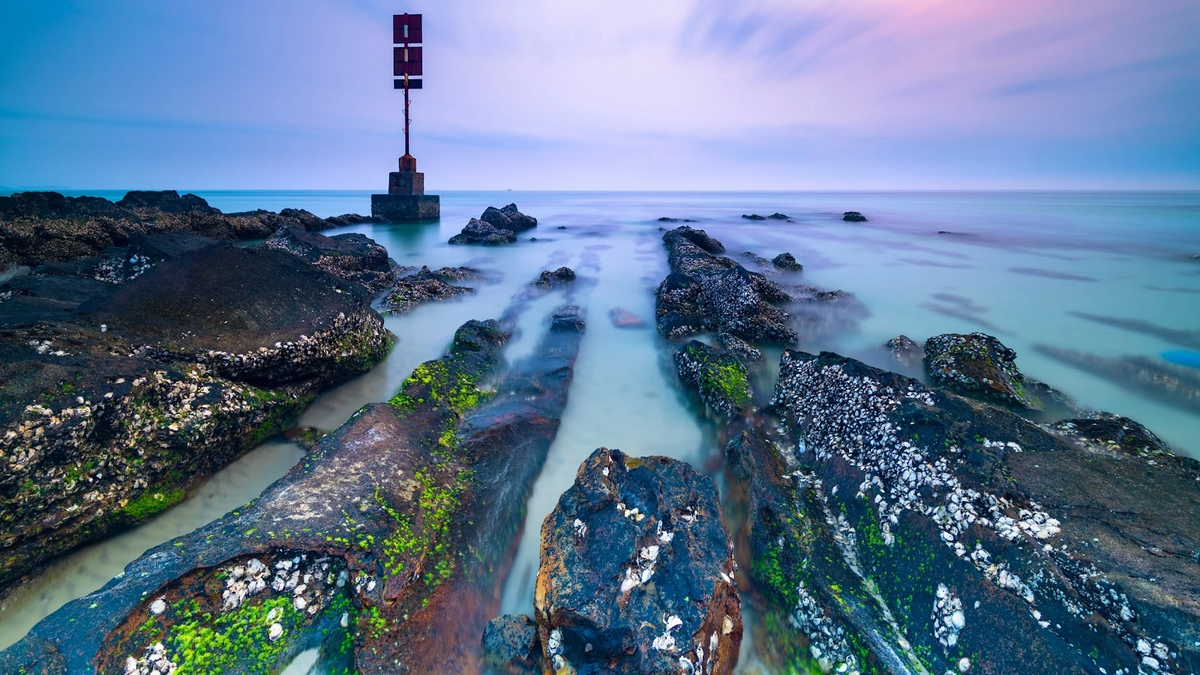

![[Photo] Thousands of Buddhists wait to worship Buddha's relics in Binh Chanh district](https://vphoto.vietnam.vn/thumb/1200x675/vietnam/resource/IMAGE/2025/5/3/e25a3fc76a6b41a5ac5ddb93627f4a7a)

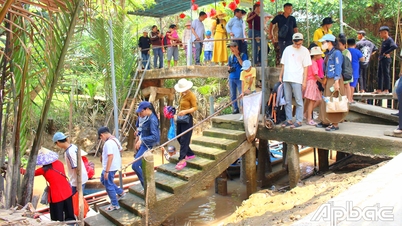

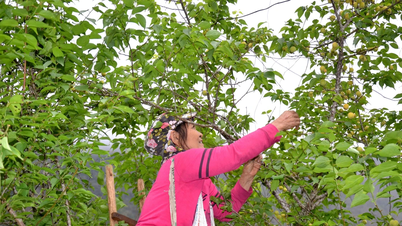
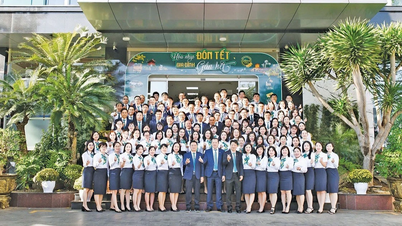







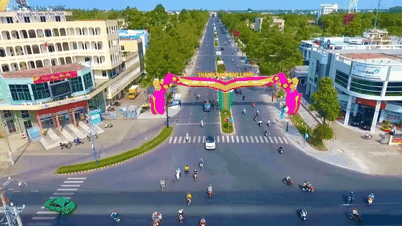
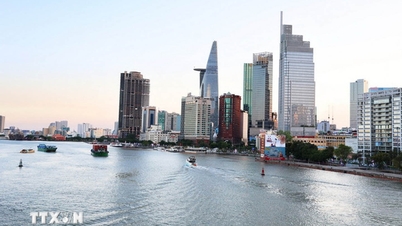


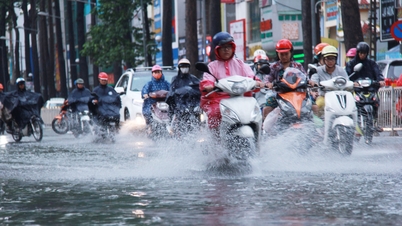
































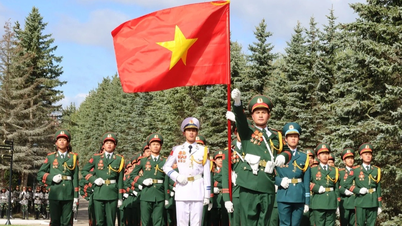





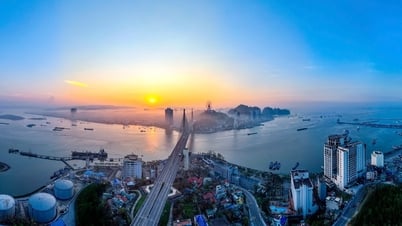
















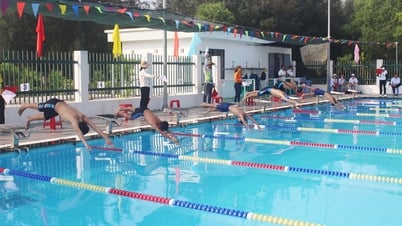











Comment (0)